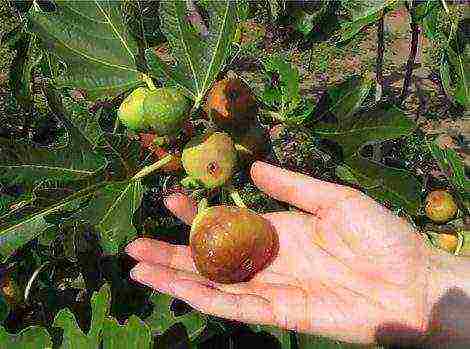Content
- 1 Platicodon - description
- 2 Platycodon plant - varieties
- 3 Platicodon - landing
- 4 Platicodon - growing and care
- 5 Platicodon - growing in pots
- 6 Platycodon - oriental flower
- 7 Platicodon at home is not a whimsical and elegant culture (with photo)
- 8 Growing platycodon from seeds, cuttings, rhizomes: planting and care
- 9 Platycodon varieties
- 10 Platicodon planting and care in the open field
- 11 Watering Platicodon
- 12 Fertilizer for Platicodon
- 13 Pruning Platicodon
- 14 Platicodon wintering
- 15 Platicodon seed cultivation
- 16 Platicodon propagation by cuttings
- 17 Diseases and pests
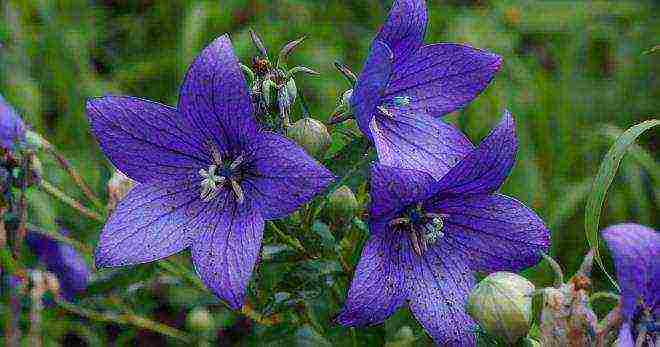
If there is a desire to decorate your personal plot or window sill in the house, then you should choose a platycodon, planting and caring for which includes several important procedures. There are several varieties that will add variety to your design.
Platicodon - description
Outwardly, this plant looks like ordinary bells, but it has a number of special features:
- Platycodon is characterized by a fleshy rhizome, thin and straight roots reaching a height of 20-80 cm and opposite leaves of an ovoid or elongated shape.
- Platycodon at home or on the street has a bluish color of stems and leaves.
- As for the flowers, they can be single or collected in panicles of several pieces. They are also large and reach a diameter of up to 8 cm.Depending on the variety, the color of the buds differs.
- Flowering is observed for two months, starting in mid-July. After that, a fruit is formed - an ovoid capsule, in which there are flat and shiny ovoid seeds.
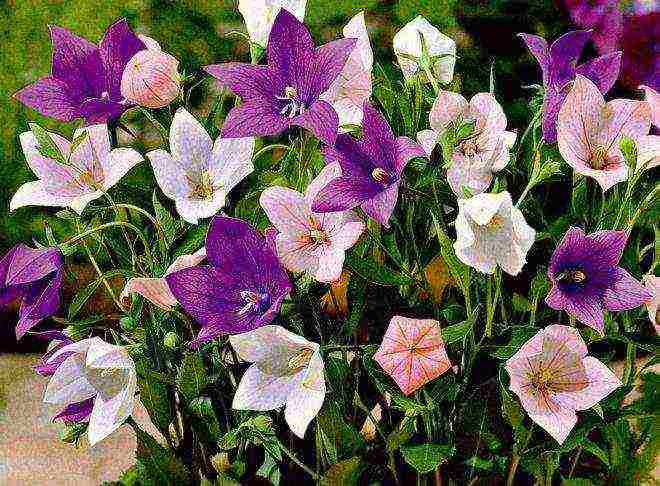
Platycodon plant - varieties
Thanks to nature and the work of breeders, there are several types of these beautiful and unusual flowers:
- Platycodon "Large-flowered". Many will agree with the opinion that this is the most delicate variety, which is characterized by single white or slightly lilac buds with blue veins. Height reaches 80 cm. Platycodon shirokokolokolchik blooms from June to August.
- Platycodon "Pink". It took a lot of effort to get this hybrid, as it turned out to be difficult to develop a variety with beautiful pink bells. The distinctive features include diminutiveness and flowering for a long time. The flower looks great both in small flower beds and in a pot on a windowsill.
- Platycodon "Blue". This variety of platycodon perennial is popular due to the presence of large blue flowers. It will perfectly fit into original multi-component compositions and will be a wonderful single decoration.
- Platycodon "Astra". This variety was bred thanks to the combination of two types: semi-double and white. The result is a compact plant that reaches a height of no more than 25 cm. The distinctive features include abundant flowering for two months. As for the flowers themselves, they are large, star-shaped and reach 7-8 cm in diameter.
- Platicodon "White". Another compact option that grows above 20 cm. It blooms with white delicate flowers, and this happens from July to August or from August to October.
Platicodon - landing
In order for a flower to please the eye, take root well and grow, it is necessary to plant it correctly, for which it is worth following a number of recommendations.
- It is important to choose the right place for growing, since it belongs to light-loving areas, it is better to give preference to well-lit or semi-shady areas.
- When choosing a platycodon for your site, planting and caring for which is simple, keep in mind that its root system is delicate and fragile, so transplants are categorically undesirable for it. Considering this, it is important to immediately choose a permanent place where the plant will delight for 7-10 years.
- Pay attention to the quality of the soil, which should be fertile, loose and well-drained. It is best to choose loams with a neutral reaction for planting Platicodon. During digging, it is recommended to add additional sand, and directly during planting 0.5 tbsp. wood ash and 1 tbsp. a spoonful of complex fertilizers.
- Correct planting of Platicodon should be carried out carefully so as not to damage the roots of the seedlings. It is necessary to make holes, the distance between which should be about 25-30 cm. Their volume should be slightly larger than the pot in which the seedlings were grown. The plant must be well watered and then removed from the container along with a clod of earth, then the chance that it will be accepted will be high.
- Water the bush at the end of the process. Mulching is recommended, as this will prevent the soil from drying out and cracking during the heat. In addition, the amount of weeds will be significantly reduced.

When to plant Platycodon?
It is necessary to select the time for planting taking into account whether seeds or seedlings are used. In the first case, one should focus on temperature indicators, so the earth should warm up by more than + 5 ° C. If you are interested in how to plant platycodon seedlings, then it is better to plant at the end of May. Due to the observance of these conditions, the chance that it will be accepted and will develop well increases significantly.
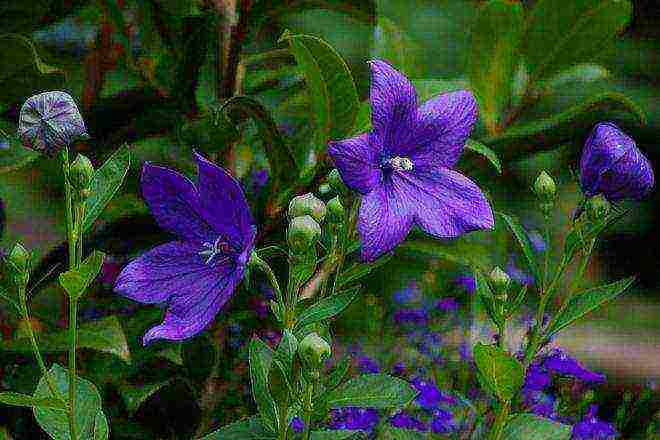
Platicodon - growing from seeds
To obtain seedlings, planting seeds must be carried out in early or mid-March. There are a number of recommendations on how to sow Platicodon, planting and caring for which has its own characteristics:
- Since the seeds are light sensitive, they should be sown closer to the surface of the ground, which should be loose and light. You can simply press the seeds with your finger without sprinkling anything on top of them.
- After that, cover the container with foil or glass, which will create the effect of a greenhouse. It is recommended to place them in a place where there is a lot of light, but the seedlings must be protected from direct rays.
- Subsequent care for Platycodon ordinary involves regular moderate watering and maintaining an optimal temperature regime (20-23 ° C).
- If everything is done according to the rules and the planting material was good, then the seedlings should appear after 2.5-3 weeks. After that, it is recommended to lower the temperature to 15-16 ° C and periodically ventilate the greenhouse by removing the film or glass. The condition for moderate watering remains.
- It is worth pointing out that platycodon, planting and care of which should be carried out according to the recommendations of gardeners, does not need stratification, that is, cold treatment, but if the procedure is carried out, then germination can be accelerated.
- When buying seeds in the fall, you can plant in the garden in the winter. They need to be planted shallow, covered with a layer of compost or sifted earth on top (2-3 cm thick). Seedlings appear in late May or early June. Platycodon will develop slowly, and flowering can be observed only after 1-2 years.
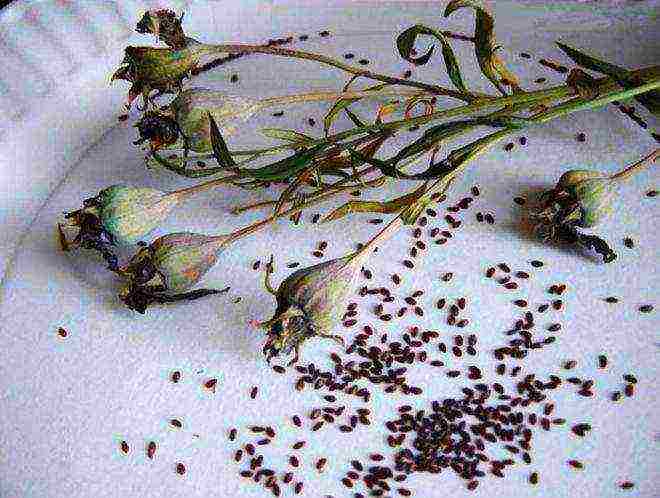
Platycodon - propagation by cuttings
You can increase the number of such plants and vegetatively. For this, it is worth considering a number of recommendations:
- In spring it is necessary to choose a stem with a heel and separate the stalk. An incision is made at the root collar. It is important that there are 2-3 internodes on the stem. The cuts are processed with garden varnish and sent to the water until the roots appear.
- Using vegetative propagation of Platycodon, you can also divide the bush. First, it should be carefully dug up and examined. If the rhizome has processes with buds, then they can be separated using a sharp knife. All that remains is to plant the bushes in the holes, observing the rules.
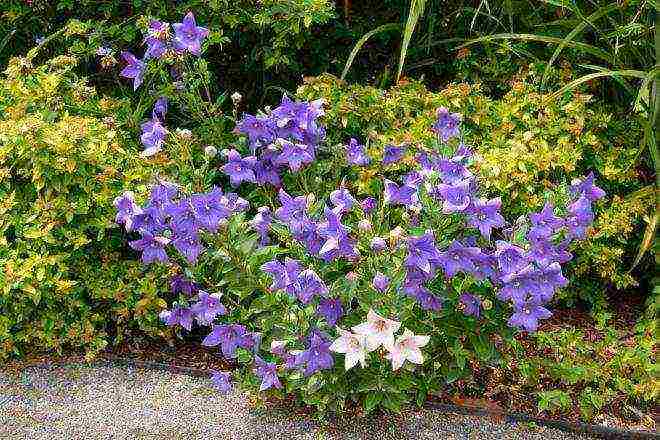
Platicodon - growing and care
For abundant flowering for many years, a number of recommendations must be followed.
- In the first weeks, watering must be carried out without fail, and then, it is worth focusing on the weather and the state of the earth. If there has been no rain for a long time, then it is better to irrigate.
- For the cultivation of platycodon, it is important to loosen the soil after watering. Please note that nearby weeds can impair growth activity, so they should be removed in time.
- For flowering platycodon, planting and care involves the introduction of complex fertilizers, and it is recommended to do this once a month. If Platicodone is not required to be high, inhibitors that reduce growth activity can be used.
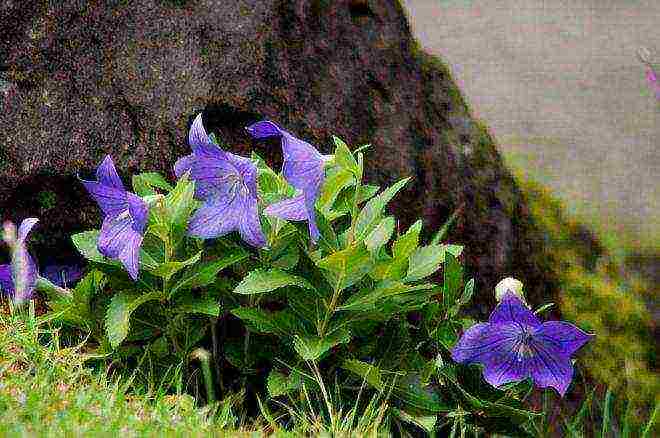
How does Platicodon rise?
Experts say that the length of the germination period depends on many factors. To a greater extent, the variety and compliance with the rules regarding planting and care are important. The minimum period is 10 days, and in some cases the period is extended to 21 days. When cultivating platycodon flowers, you should know that when the seedlings get stronger, it is important to remove the film, and when forming four leaves, it is recommended to feed with nitrogenous fertilizers.
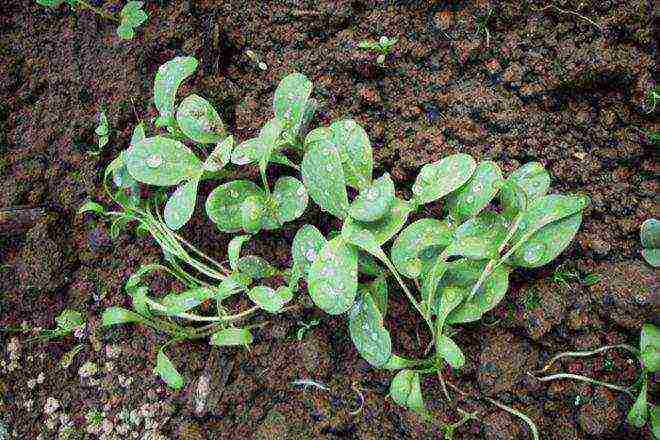
Platycodon - flowering
In most varieties, axillary flowers bloom at the tops of the shoots in mid-June, which are collected in a paniculate inflorescence of 2-5 pcs. The buds have a short and flexible peduncle, so they tilt slightly downward. The corolla consists of five petals fused at the base, so it looks like a bell. There are semi-double varieties in which the petals are placed in several tiers. It is important to note that flowering continues for two months. There are no special rules on how to care for Platycodon during the flowering period.
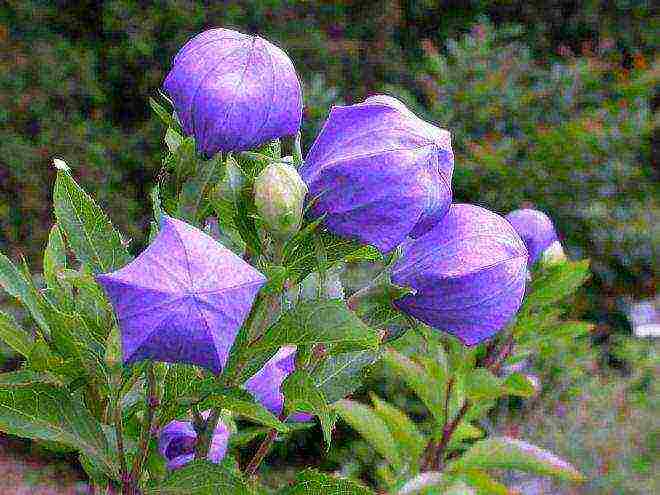
Platycodon picking
In order for the plant to start growing faster, giving shoots, it is necessary to carry out a simple procedure - a pick. On young seedlings, the top is cut off when the third pair of leaves is already formed. Caring for platycodon involves the use of a container with a diameter of about 10 cm for picking. In the same containers, it will grow before it can be transplanted into the ground. It is allowed to lower the pick if the seeds are sown in peat tablets.
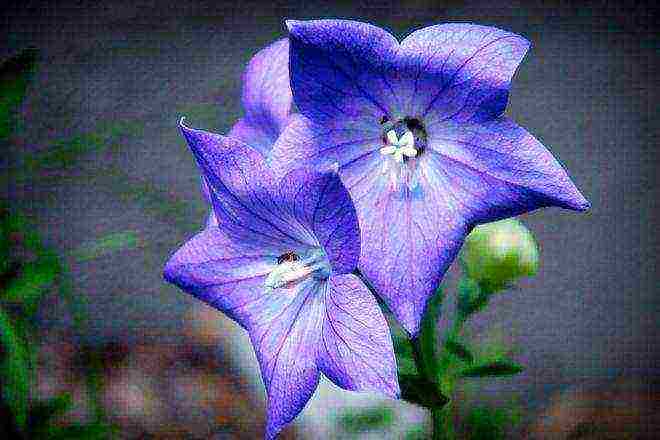
How does Platicodon winters?
When growing flowers in the garden, it is important to properly prepare them for the winter period. To do this, you should take into account a number of recommendations:
- Before the onset of cold weather, cut off the entire ground part so that only the roots remain.
- For cultivation and care in the open field, Platikodon must be covered with fallen leaves, peat or other similar material for the winter. The height of the mulch depends on the terrain and the further north the territory, the thicker the protection should be.
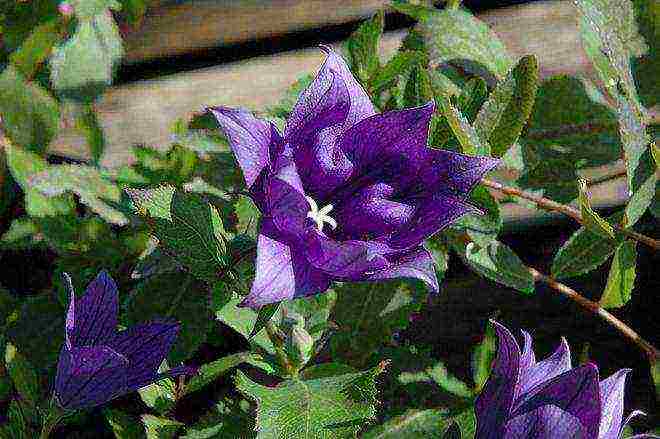
Platicodon after winter
When the cold weather recedes, it is necessary to clean the bush by removing the shelter. Note that it is worth doing this when there is no night frost. Experienced gardeners recommend fertilizing the bushes in the spring using humus or peat. It is important to monitor the acidity of the soil. If Platycodone is growing at home, then it is better to transplant into a new pot.
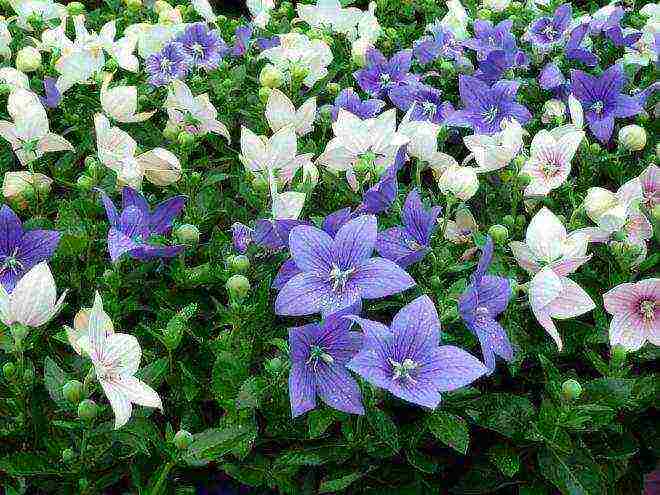
Platicodon - growing in pots
It has already been said that you can grow a plant at home and in this case you need to use the seeds as seedlings for open ground.
- When growing a platycodon flower, as a houseplant, it is recommended to put the pot on a well-lit windowsill, but keep in mind that direct sunlight can provoke a burn.
- The optimum home temperature is 20 ° C.
- When withering buds appear, they should be removed, and the earth around it should be periodically loosened.
- If you want to breed platycodons, planting and caring for which are very simple, it is important to take into account that they do not tolerate waterlogging in a pot, so watering should be moderate, and reduced to a minimum in winter. In addition, in the cold season, the pot must be moved to a cool place where the temperature is 13-15 ° C.
- Spraying is not necessary, and it is recommended to feed the bush before the bells appear.
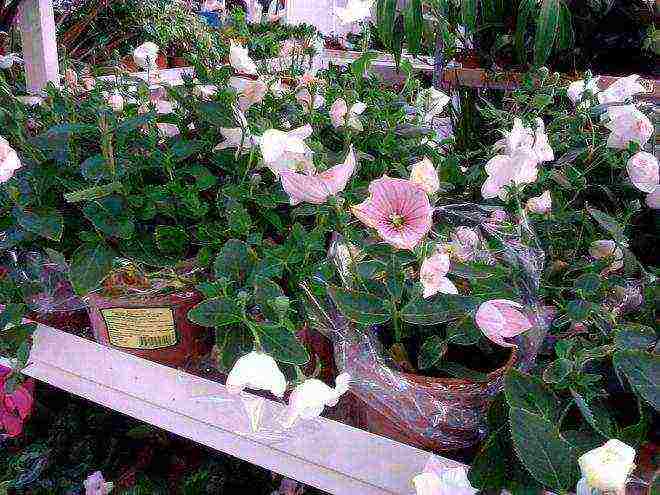
Consider a plant with the Latin name Platycodon grandiflorum. It belongs to the Bellflower family and is considered one of the most beautiful. A bright platycodon turns a photo of a front garden into a motley panel. In Russia, the flower is sometimes called broadly-bell. A very beautiful bell is successfully used in landscape design and in indoor conditions for landscaping interiors. The beautiful flower, native to Japan, is available today for growing in a variety of climates. This is facilitated by long-term selection work and the breeding of hybrid forms. Large-flowered platycodon at home does not require special care, usually planting is carried out by seeds. They germinate rather quickly. By the way, for growing in the garden, it is also advisable to breed this perennial crop by seed seedlings. If proper care of the seedlings is carried out, then flowering occurs already in the first year of the flower's life. Look at the photo of the Platikodon flower, they will clearly show all the sophistication and beauty of the plant:
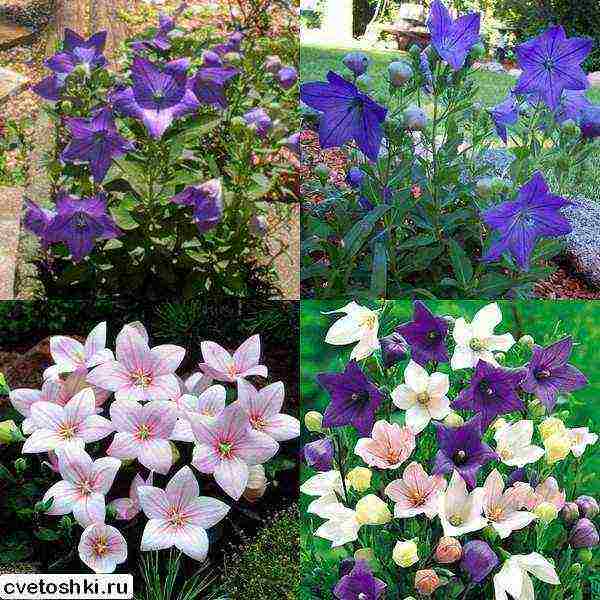
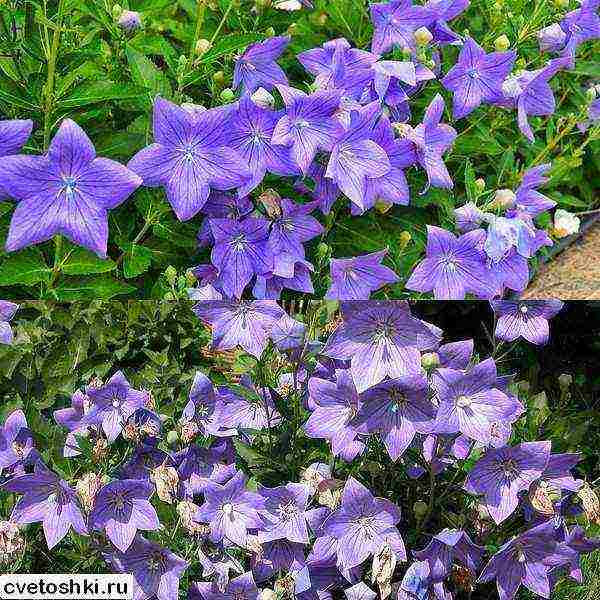
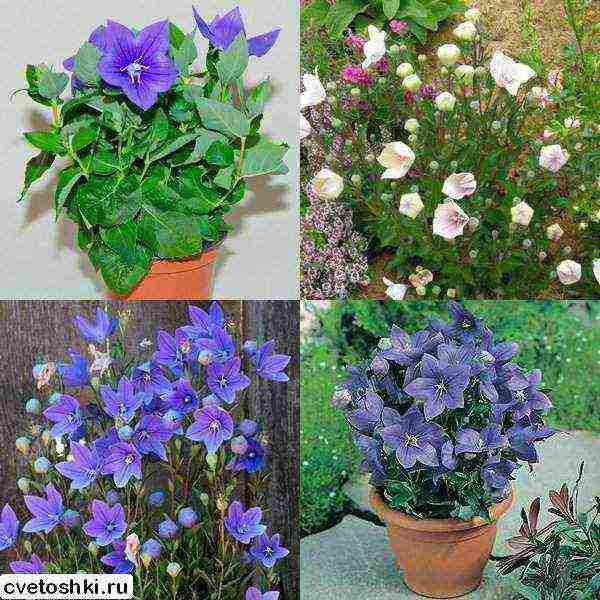
Platycodon - oriental flower
Japan is considered the birthplace of the magnificent bell, as well as the Ussuri region, Manchuria and China. Nevertheless, he perfectly took root in European gardens. In central Russia, gardeners observe the emergence of shoots from the ground in the 2nd half of May. And it blooms in July-August. Just as there is no oriental Platikodon flower, which amazes the imagination with its variety of shapes and shades of petals. Its color ranges from white to purple. Light petals are pierced with blue veins, and, for example, large-flowered platycodon (dwarf "Hanus Pink") shows a bright pink hue. The most popular varieties are:
- Fuji White and Fairy Snow (white);
- Fuji Blue (blue);
- Fuji Pink (platycodon pink);
- "Alba Plena" and "Captivity" - terry platycodon, white and blue;
- "Bumilus" is purple.
All varieties are divided into ordinary and dwarf. Ordinary stems are very unstable. At dense planting of mixborders, “smoothing” occurs. If the flower is planted far from other plants, the stems will have to be tied up. Dwarf large-flowered varieties are devoid of such a drawback. Among them are Alpinus (30 cm), Apoyama (25-30 cm), Pumilus (15 cm), Hanus (15 cm). Beautiful "Hanus Alba" and "Hanus Pink" with white and pink inflorescences, respectively.

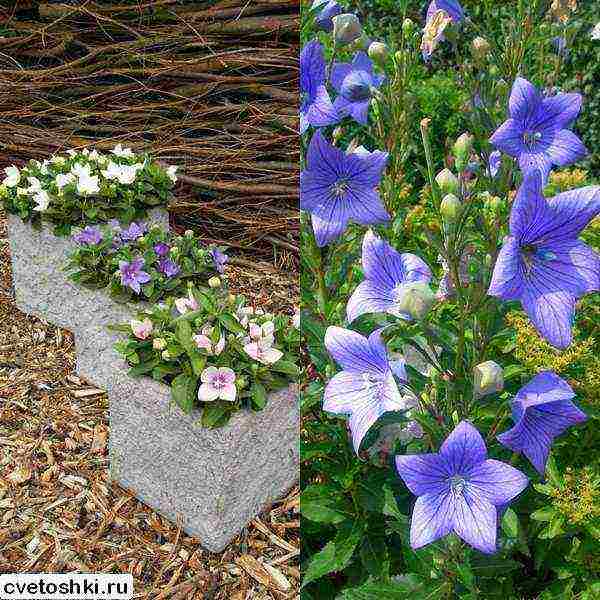
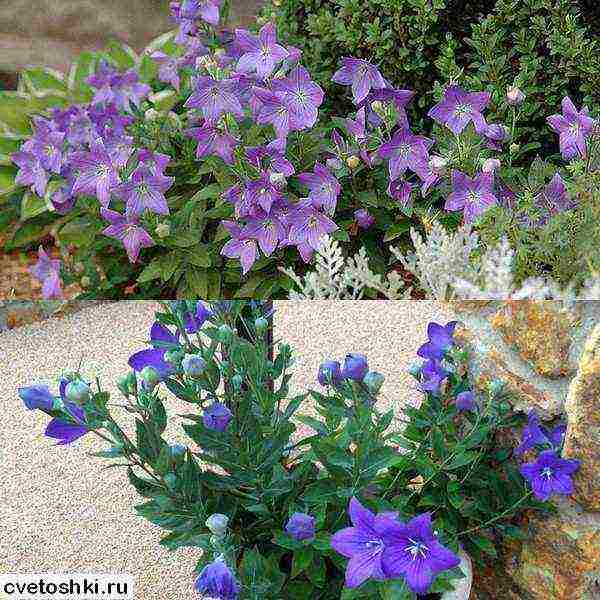
Platicodon at home is not a whimsical and elegant culture (with photo)
This culture, quite unpretentious to environmental conditions, attracts attention with its abundant flowering. The elegant shape of petals and greenery creates a colorful composition in well-lit areas. If necessary, additional supplementary lighting with a phytolamp is required. We list the basic rules that will help you grow and maintain Platycodon at home
:
The root system of the plant is distinguished by a pronounced central root. Flower-stalks emerge from the root collar. They are attractive already at the stage of emergence of broadly lanceolate leaves with a jagged edge and a pointed "nose". The color of the leaves is dark green and the texture is tough. The leaves are arranged whorled (3 pcs. In a whorl) or opposite. The end of the stem is crowned with a rare panicle with 2 - 5 large flowers, each of which can reach 8 cm in diameter. After flowering, the petals are replaced by seed pods, in which the seeds have ripened.Before winter, the stems must be cut off, and the root collar must be mulched. Look at the photo of flowering plants at home:
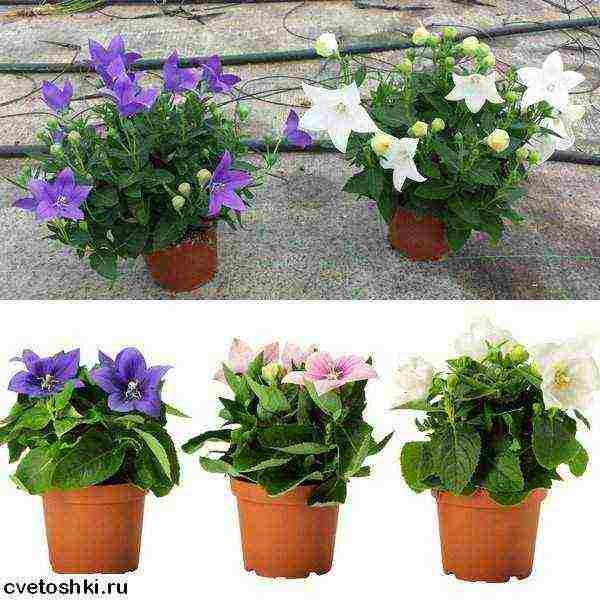
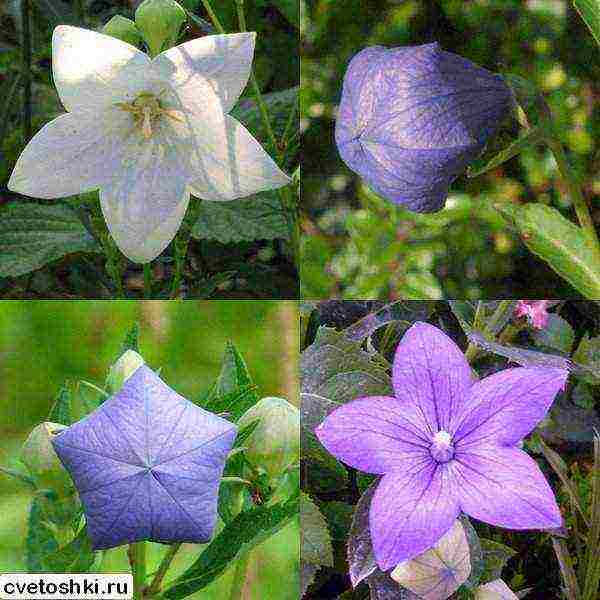
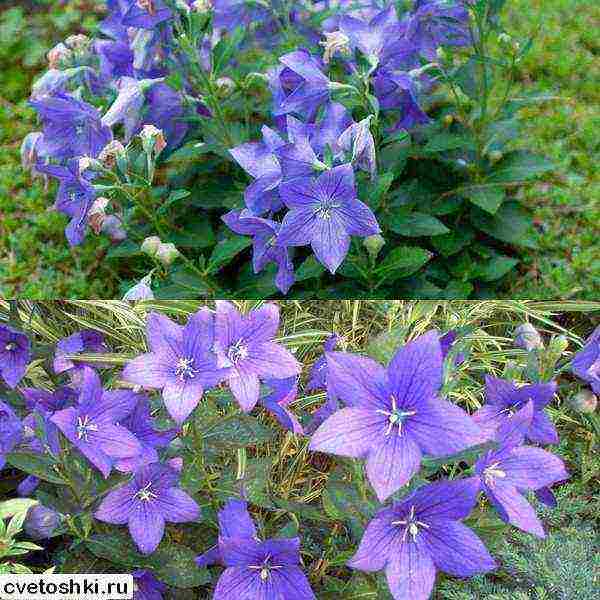
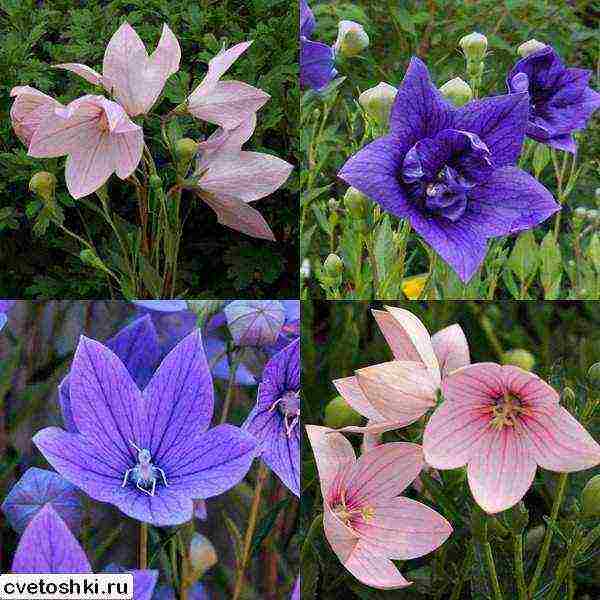
Growing platycodon from seeds, cuttings, rhizomes: planting and care
There are 2 main methods of flower reproduction: seeds and vegetative. A lot of seeds are born in capsule fruits. They are small and light sensitive. Cultivation of platycodone from seeds begins by sowing without embedding in the soil. When breeding from cuttings and rhizomes, planting and subsequent care are somewhat different, but only at the initial stage. If you plant several varieties next to each other, then all varietal characteristics will be lost. When there is only 1-in variety in the garden, then it will convey all the signs, incl. dwarfism, future generations. Seeds do not require stratification. Submerged in indoor boxes in March, they will germinate in 12 days. However, seedlings will bloom only in the 2nd year. Vegetative propagation involves the use of stem cuttings with "heels". At the end of May, when 3 internodes are observed on the stem, cuttings are cut from the root collar with a sharp knife. Experienced growers propagate the plant by dividing the rhizomes. But in this case it is hard to take root. For the Platikodon bell, planting should fall on the 1st half of the warm season. To do this, prepare a hole, into which 0.5 cups of ash and 1 tbsp. a spoonful of mineral fertilizer (full). For a dwarf variety, 1 teaspoon of fertilizer will suffice. Two weeks after planting, regular watering and shading from the bright sun will be required. In one place, without any displacement, the plant can live up to 7 years.
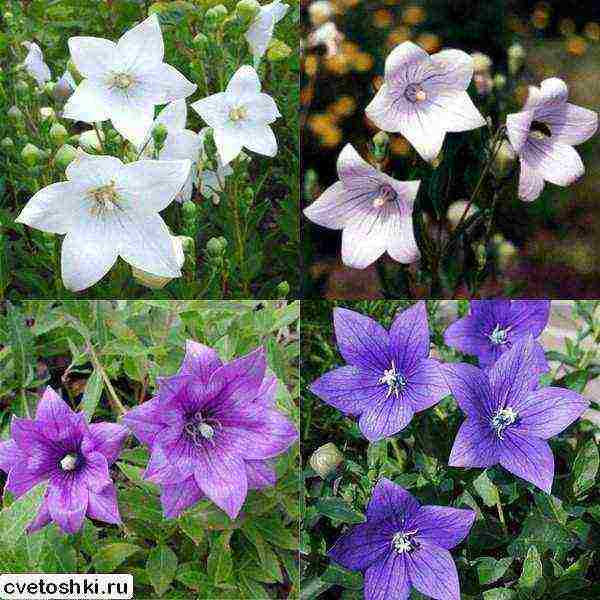
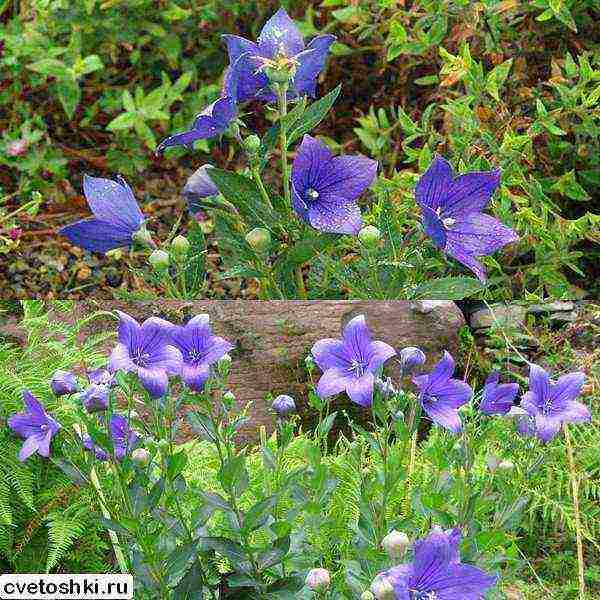
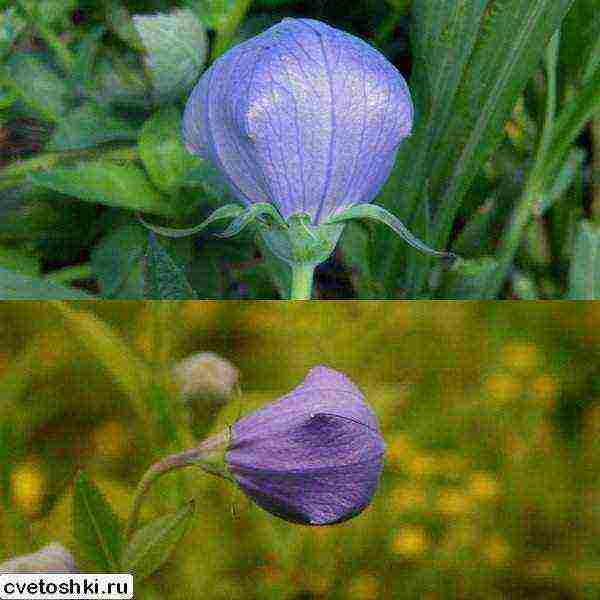
It is convenient to buy a new thing for the garden in a floriculture or a special company in the middle of summer. The gardener will become the owner of a container with already blooming platycodon. Until mid-August, plants can still be transplanted into the ground. With a later acquisition, it is better to postpone the transplant until next spring. And for this you will need to perform several "magical" actions. Find an elevated spot in the garden. Dig in the container there. Cut off the stems before winter. Cover the box with lutrasil until spring. To counteract the instability of the stems, densely planted flower beds are recommended. Dwarf varieties are planted in the foreground of mixborders and in rockeries. Daylilies and irises are considered the best neighbors of the bell. Beautiful combinations give thin-legged, fescue or white-grass. A special effect is demonstrated by contrasting pansies planted side by side. What kind of care is required for Platicodon after its successful transfer to a permanent place of "residence"? There are a few simple rules to follow. Planted both in open meadows and in partial shade, flowers require fertile and permeable soil. They don't like excess soil moisture. Therefore, during the entire period of development and growth, the green friend needs moderate watering. Excess moisture easily provokes disease. Rot can attack the root collar and roots. If the leaves become spotty, then the owners overdid it with watering. Shoots and cups should be rid of insects. The most dangerous pest is the spider mite. To preserve aesthetic appeal, faded bells are removed from flowering plants. The stalks need a garter. Terry varieties are especially in need of it. The described representative of the flora belongs to the winter hardy. It tolerates frost without any special shelter. However, caring gardeners prefer to protect the root collar and mulch it for the winter with a 2 cm layer.
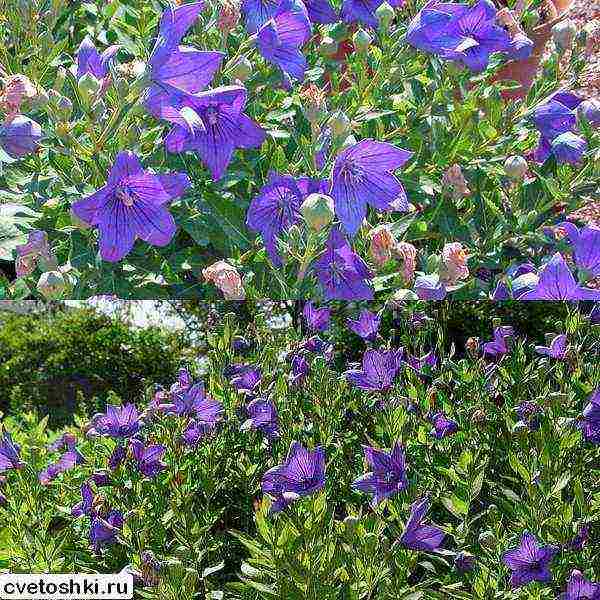
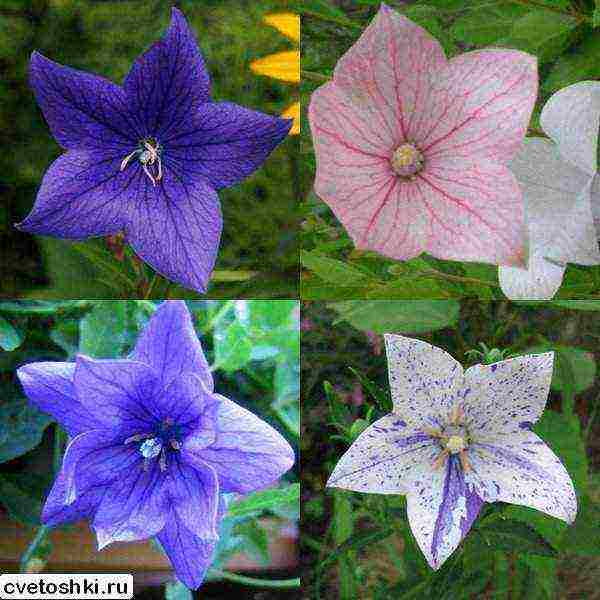

The genus Platycodon (shirokolokolchik) belongs to the Kolokolchikov family and includes only one species - the large-flowered platycodon or grandiflora. This only member of the genus is a herbaceous perennial that lives in forests and on rocky slopes.
This plant has rather powerful roots, tall shoots, covered with a large number of leaves. The lower foliage is collected in an outlet. All greens have a bluish color. In inflorescences up to 5 wide flowers are formed, veins are clearly visible on the petals.
Platycodon varieties
The color of the flower depends on the variety and can be pink, whitebut the wild bell has pale blue color with dark streaks.
Several varieties have been created from one species, which are generally similar, but have differences in the color of the petals, their type (for example, double petals), as well as the size of the bush, because there are dwarf platycodons.
Varieties of the Astra type with the corresponding color of flowers are quite popular:
- Platycodon astra pink;
- Platycodon astra blue;
- Platycodon white.
If the flowers are double, then this is indicated in the name. Another type of aster is distinctive in that it is undersized plants, and this variety also has a variety Double, the flowers of which have two rows of petals, and the veins on them, although clearly visible, are not as pronounced as in the variety platycodon pink florist (bloody veins protrude against the delicate scarlet background).
Type varieties Platicodon Fuji taller, have only one row of petals, and their color is slightly softer.
to the table of contents
Platicodon planting and care in the open field
You need to plant the plant in open soil at the end of spring, when you are sure that the temperature will not drop too low at night.
The site for planting should be well lit, but in general, the shirokolkolchik can withstand growth in partial shade. The soil should be nutritious and loose, have drainage. The best substrate is sandy loam with neutral acidity.
This flower has vertically growing roots, so it is impossible for groundwater to be close to the site. Its rhizome is very delicate and does not tolerate transplants, therefore, the bushes grow in one place for over 10 years.
Before planting, the site must be dug up, at the same time adding half a glass of tree ash and a tablespoon of complex mineral fertilizing per square meter to the soil.
Planting holes should be slightly larger than seedling pots. The distance between the individuals is about 30 cm. When replanting the plant in open soil, pre-water it abundantly to facilitate the process, and then move it into the pit by transshipment with the soil and fill it completely.
You can also familiarize yourself with the method of growing a Carpathian bell at home in here.
to the table of contents
Watering Platicodon
The first 15 days after planting, young plants need to be watered every day. Further, watering begins to be reduced and, as a result, they do it as the soil dries out. Adult bells can tolerate heat and dryness normally.
Along with watering, you need to loosen the soil around the plants and get rid of weeds. We advise you to cover the planting site with mulch, then these procedures can be done less often.
to the table of contents
Fertilizer for Platicodon
If the site is timely covered with organic mulch (for example, compost or humus), then additional fertilization is not necessary.
If this is not possible, then in the spring a complete mineral dressing for flowering crops is introduced.
to the table of contents
Pruning Platicodon
Shirokokolokolchik grows strongly upward. To avoid excessive stretching of the shoot, you need to pinch it for a year, or use inhibitors every year.
If you missed this moment and the stem is pulled up, then tie it up to maintain a beautiful appearance. Sluggish flowers should be cut off for longer fresh flowering.
to the table of contents
Platicodon wintering
As already mentioned, the root system of the shirokokolokolchik is very fragile, so transplants are contraindicated for it. When flowering ends, seed pods will appear, from which, after drying (this happens around the beginning of autumn), you can collect seeds.
For the winter, the stem of the plant is cut off, and the site is covered with humus mulch or dry foliage. With the arrival of spring, the shelter must be removed so that the plants do not get caught up and infection does not occur.
to the table of contents
Platicodon seed cultivation
The most reliable breeding method is seed. You need to sow the material in early-middle spring. To do this, take soil for flower plants, which can be made from a mixture of humus, sand and peat soil in equal proportions.
It is not necessary to sow plants deeply - by about 3-4 mm. The sowing is kept at room temperature, watering from time to time, when the entrances appear - and this happens in 15-20 days - the temperature is reduced to 16 ° C.
Further, the seedlings are kept in this way before planting in an open substrate. You can also sow before winter by covering it with a couple of centimeters of compost.
to the table of contents
Platicodon propagation by cuttings
Other methods of propagation, such as cuttings and dividing the bush, are unreliable, and if the cuttings can still be taken, then dividing the bush almost never gives the desired results.
To use propagation by cuttings, you need to cut off the shoots with a pair of internodes and a heel from the shoot.
Further, the procedure is the same as with cuttings of other plants - germination of roots in water or sand and planting in a pot until the end of development.
to the table of contents
Diseases and pests
Platicodone is very resistant to disease. Basically he only suffers from rot, which appears due to waterlogging. If rotting is found, reduce watering and loosen the soil for better drying.
But if this does not help or the rot has spread greatly, then it is better to remove the flowers and disinfect the area with a fungicide. Repeat disinfection after a week.
The most dangerous pests are rodents - moles, mice.
Mice and moles are usually literally smoked out, letting the smoke into the hole, because it probably leads to a tunnel. You can also leave poisoned cereals on the site, which will help get rid of the mice.
Poisons are not used against moles in the garden or in the garden. To scare them away, rattles are made, placed on pegs, which will create noise in the wind.
It is also worth noting that moles do not dig the ground where there are daffodils, onions, garlic, euphorbia, marigolds. And note that if the land on the site is not too wet and is not replete with insects, then there will not be many moles on it.
to the table of contents
Among all the bell-shaped ones, there is a special species - platycodon. Growing it is not difficult, but you just have to look at the photos of this amazing flower, and it will become your favorite.
- Outdoor cultivation
- Sowing in containers
- Features of transplanting to a flower bed
- Care
- Don't let the plant grow up
- Wintering
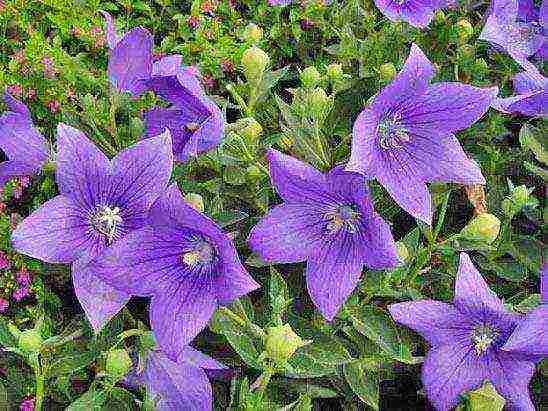
Almost everyone who sees Platycodon “live” for the first time admires it. For its large multi-colored bells, which attract the attention of both professionals and novice florists, it received its second name - shirokokolokolchik.
This is a perennial herb that propagates by seed and vegetatively. Seeds can be sown both directly on the beds and in special containers. If you want to bloom in the same year, you should start planting in winter.
Growing in the open field ↑
It is not recommended to plant seeds immediately on a flower bed, since platycodon will bloom only after a year and a half when grown from seeds. Therefore, we specially highlight the sowing bed in the garden, always in partial shade, dig it up and carefully level it.

Seeds are sown in late autumn in rows or in narrow strips (3-5 cm), lightly sprinkle with earth (0.5-1 cm) and water. The seeds germinate quite amicably next spring. Now all that remains is to water and weed them regularly. Young plants are transferred to the flower bed only next fall.
Sowing in containers ↑
The seeds are sown in containers in January-February.At the same time, they are not pressed into the ground, but only lightly sprinkled with light soil, covered with a film and placed in a warm place (20 -22 degrees). Within 8-10 days, the shirokokolokolchik germinates, and only after that the film is removed.
When three to four pairs of leaves appear on the seedlings, they are transplanted three plants into a pot with a diameter of 12-13 centimeters. Bells can grow in them before the onset of a warm time, when they must be transferred to a flower bed. The first buds will appear 16-18 weeks after germination.
Features of transplanting to a flower bed
It is advisable to transplant flowers in spring or autumn - both young and adult Platycodon, planting and caring for which differ little.
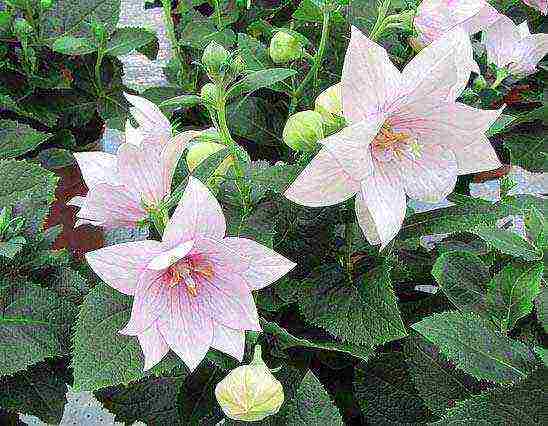
Almost everyone unanimously says that this perennial does not tolerate any digging and transplanting, but I myself have done this many times at the most inopportune time (in the heat) and everything went well. Of course, this required the utmost care and attention.
For those who need to do this in unfavorable conditions, we advise you to keep all the small roots on the rhizome. Before digging, the plant must be watered, carefully removed from the ground and lowered into a bucket of water for 20 minutes. Only then should it be planted in a new place.
In a flower garden, specimens should preferably be located at a distance of 15 to 20 centimeters, no more. With this arrangement, heavy bushes support each other, and the entire mass of stems does not disintegrate in different directions.
Care ↑
In the first week, the transplanted Platycodon is watered every day, unless it rains. The ground should always remain slightly damp. After 10 days, the amount of water is gradually reduced.
Caring for a shirokokolokolchik is extremely simple, you just need to remove weeds and water, even feeding is optional.
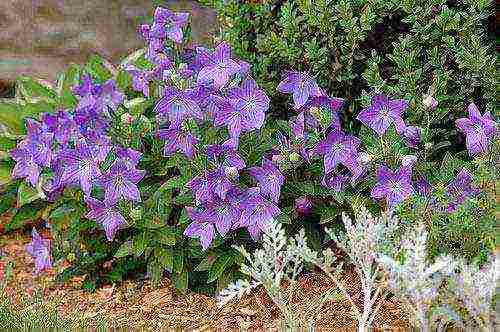
When watering, it is worth remembering that this beautiful perennial can do without watering for a long time. But if he lacks moisture, double and semi-double flowers become common and slightly decrease in size.
Feeding is optional, but desirable. They are carried out using organic and floral mineral fertilizers. It is best to do this no more than once a month.
Don't let the plant grow upward ↑
When grown, platycodones become taller than indicated in the variety description. This usually occurs in the third year of growing in a flower bed.
In order to keep the plants low in height, I treat them with an inhibitor (a growth-arresting agent) in early spring, when the shoots are still very small.
I use the drug "Athlete", which is sold in any garden center or store. Such processing keeps shirokokolokolchiki low for 1-2 years.
Wintering ↑
In terms of frost resistance, these flowers can grow well from zones 3 to 10. That is, in the Moscow and Leningrad regions, for example, they winter well without shelter.
But you never know what winter is coming, so it's best not to risk it and get ready. To prevent perennials from freezing, they should be covered with peat, soil, buckwheat or sunflower husks. The height of the mulch depends on the zone - the further north, the thicker the protection. In this case, you do not need to pluck the foliage and cut the stems. The plants are cleaned in the spring, when the shelter is removed.
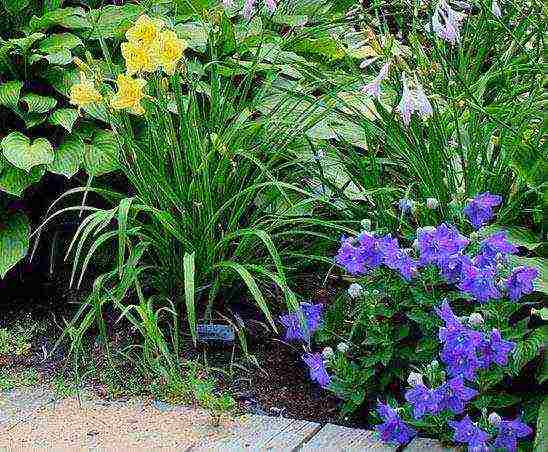
Platicodon has been growing in my garden for 12 years now. Growing, although it does not take much time, however, as you noticed, has its own characteristics. And if you follow all our recommendations, it can successfully grow and bloom in a flower bed for more than 10 years. At the same time, almost all varieties of shirokokolokolchik are long-livers, just choose the color and shape of the bells to your taste.
